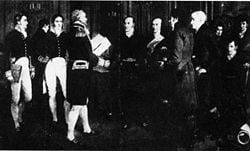Treaty of Ghent
The Treaty of Ghent, signed on December 24, 1814, in Ghent, Belgium, was the peace treaty that ended the War of 1812 between the United States and the United Kingdom of Great Britain and Ireland.
Negotiators for Britain included minor diplomats William Adams, James Lord Gambier, and Henry Goulburn. Meetings were often delayed a week or more as the British diplomats awaited orders from London. The American delegates, however, included senior political leaders who had full authority to negotiate. They were John Quincy Adams, James A. Bayard, Sr., Henry Clay, Albert Gallatin, and junior member Jonathan Russell.
The war had become a stalemate and the treaty returned the two countries to the status quo before the war. The treaty afforded the United States the recognition that its Navy was equal to the British Navy and that the British were no longer free to press United States sailors into the service of the United Kingdom.
War of 1812
Neither side had been successful in invasions designed to gain bargaining chips. The United States strategy was not to annex Canada as much as it only wanted to seize lands for bargaining over other issues. The prewar issues of trade restraints and impressment of United States sailors into the Royal Navy were so closely tied to the European war against Napoleon (now in exile) that they no longer mattered and were not mentioned. The Indian menace had been destroyed, ending a major cause of the war. Public opinion strongly desired peace and there was no reason to continue the war. The treaty restored prewar boundaries and released all prisoners. The treaty made no major changes, but did make a few promises. Britain promised to return captured sailors and other American citizens, but instead a few years later paid the U.S. £250,000 for them. British proposals to create an Indian buffer zone inOhio and Michigan collapsed after the Indian coalition fell apart. Weak guarantees regarding American treatment of the Indians in article IX were ignored.
Fighting immediately stopped when news of the treaty reached the battlefronts, but this happened after the Americans commanded by Andrew Jackson won a decisive victory at the Battle of New Orleans in January 1815. The U.S. Senate unanimously approved the treaty on February 16, 1815, and President James Madison exchanged ratification papers with a British diplomat in Washington on February 17‚ÄĒthe treaty was proclaimed on February 18. Eleven days later (March 1) Napoleon escaped from Elba, rekindling the European wars, and forcing the British to concentrate their forces against the threat he posed.
After Effects
The War of 1812 made the United States a stronger nation. Americans became more united and patriotic. Albert Gallatin, Secretary of the Treasury from 1801 to 1813, said that before the conflict Americans were becoming too selfish and too prone to think in local terms.
The war has renewed and reinstated the national feeling and character which the Revolution had given and which were daily lessening. The people have now more general objects of attachment, with which their pride and political opinions are connected. They are more American; they feel and act more as a nation; and I hope that the permanency of the Union is thereby better secured.
ReferencesISBN links support NWE through referral fees
- Bailey, Thomas Andrew. A diplomatic history of the American people. Englewood Cliffs, N.J.: Prentice-Hall, 1980. ISBN 9780132147262
- Bemis, Samuel Flagg. John Quincy Adams and the foundations of American foreign policy. Westport, Conn: Greenwood Press, 1981. ISBN 9780313226366
- Heidler, David Stephen, and Jeanne T. Heidler. The War of 1812. Greenwood guides to historic events, 1500-1900. Westport, Conn: Greenwood Press, 2002. ISBN 9780313316876
- Hickey, Donald R. The War of 1812: a forgotten conflict. Urbana: University of Illinois Press, 1989. ISBN 0252060598
- Remini, Robert Vincent. Henry Clay: statesman for the Union. New York: W.W. Norton, 1991. ISBN 0393310884
- Rodgers, Ned, Ralph Phillips, Leon Ishmael, Greg Heimer, and John Rodgers. Documents of destiny. Just the facts learning series. Thousand Oaks, CA: Goldhil Educational, 2003.
- Van Buren, Martin. Boundary between the United States and Great Britain message from the President of the United States, transmitting the information required by a resolution of the House of Representatives of the 28th May last, in relation to the boundary between the United States and Great Britain. 1982.
- White, Patrick Cecil Telfer. The critical years: American foreign policy, 1793-1823. New York: Wiley, 1970. ISBN 9780471940708
External links
All links retrieved May 2, 2023.
- Treaty of Ghent and related resources at the Library of Congress
- War of 1812-1814
- Treaty of Ghent - 1814
- Treaty of Ghent (1814)
Credits
New World Encyclopedia writers and editors rewrote and completed the Wikipedia article in accordance with New World Encyclopedia standards. This article abides by terms of the Creative Commons CC-by-sa 3.0 License (CC-by-sa), which may be used and disseminated with proper attribution. Credit is due under the terms of this license that can reference both the New World Encyclopedia contributors and the selfless volunteer contributors of the Wikimedia Foundation. To cite this article click here for a list of acceptable citing formats.The history of earlier contributions by wikipedians is accessible to researchers here:
The history of this article since it was imported to New World Encyclopedia:
Note: Some restrictions may apply to use of individual images which are separately licensed.
